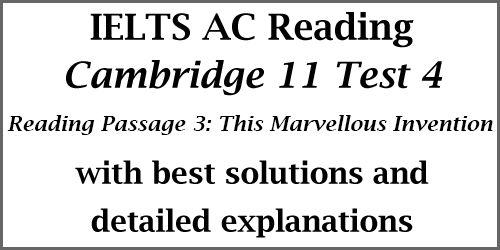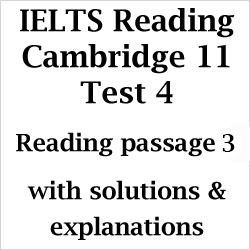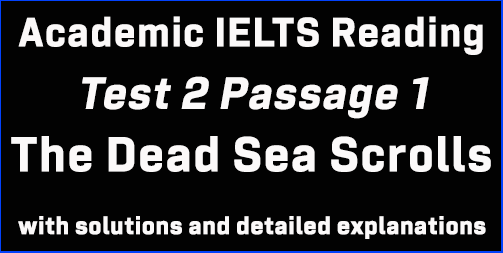IELTS Academic Reading: Cambridge 11 Test 4, Reading Passage 3: This Marvellous Invention; with best solutions and explanations
This IELTS Reading post deals with Cambridge 11 Reading Test 4 Passage 3 which is entitled ‘This Marvellous Invention ’. This post covers all the answers and solutions for Reading Passage 3. This is another intended post for candidates who have the most difficulties in finding and understanding IELTS Reading Answers. This post can simply guide you the best to figure out every Reading answer without trouble. Finding IELTS Reading answers is a gradual custom and I hope this post can assist you in this topic.

Reading Passage 3:
The headline of the passage: This Marvellous Invention
Questions 27-32: (List of headings/ Matching Headlines):
[In this question type, IELTS candidates are provided with a list of headings, usually identified with lower-case Roman numerals (i, ii, iii, etc,). A heading will refer to the main idea of the paragraph or section of the text. Candidates must find out the equivalent heading to the correct paragraphs or sections, which are marked with alphabets A, B, C, and so forth. Candidates need to write the appropriate Roman numerals in the boxes on their answer sheets. There will always be two or three more headings than there are paragraphs or sections so some of the headings will not be used. It is also likely that some paragraphs or sections may not be included in the task. Generally, the first paragraph is an example paragraph that will be done for the candidates for their understanding of the task.
TIPS: Read the first two lines, and occasionally, the last line of each heading. In most cases, the answers are found here. Do it for all the paragraphs. Do not read too much. If you still don’t find the answers, only then, read the remaining texts.]
Question 27: Paragraph A
In paragraph A, we find two different lines which confirm our answer. The first line is line no. 1 which says, “Of all mankind’s manifold creations, language must take pride of place.” The second line is line no. 3 which says, “… Compared to language, all other inventions pale in significance, since … … . .” These two lines explain that language is the best invention of all.
So, the answer is: vi (Why language is the most important invention of all)
Question 28: Paragraph B
In paragraph B, again, the first and last lines give us the answer. Line 1 & 2 says, “.. . . . In its own right it is a tool of extraordinary sophistication, yet based on an idea of ingenious simplicity: . . ..” Here, the writer gives us the impression that language is something that is special (extraordinary sophistication) yet it is of an idea which may surprise us because of the creative simplicity (ingenious simplicity), and this is why it is incompatible or mismatched. Also, take a look at the last lines, “Language is mankind’s greatest invention – except, of course, that it was never invented. This apparent paradox is at the core of our fascination with language, and it holds many of its secrets.” Here, paradox = irony or contradiction or mismatched.
So, the answer is: iv (Apparently incompatible characteristics of language)
Question 29: Paragraph C
In paragraph C, first, the writer asks in line 2-3, “How else could this instrument make so much out of barely three dozen measly morsels of sound?” Then, we find in the next few lines the explanations of how the alphabets or letters work out by arranging themselves to make perfect sounds that can be conveyed into a language. “In themselves, these configurations of mouth – p, f, b, v, t, d, k, sh, a, e and so on –amount to nothing .. . . . . . But run them through the cogs and wheels of the language machine, let it arrange them in some very special orders, and there is nothing that these meaningless streams of air cannot do: from sighing the interminable boredom of existence to unravelling the fundamental order of the universe.”
Here, barely three dozen measly morsels of sound = a few sounds
So, the answer is: ii (The way in which a few sounds are organised to convey a huge range of meaning)
Question 30: Paragraph D
In paragraph D, the writer talks about the universal or worldwide or common ability to use language “The language machine allows just about everybody – from pre-modern foragers in the subtropical savannah, to post-modern philosophers in the suburban sprawl – to tie these meaningless sounds together into an infinite variety of subtle senses, and all apparently without the slightest exertion.” This means that language is universal to use.
So, the answer is: vii (The universal ability to use language)
Question 31: Paragraph E
In paragraph E, the writer states, “Often, it is the only estrangement of foreign tongues, with their many exotic and outlandish features, that brings home the wonder of language’s design.” This means the more a language is different from other language, the more it becomes impressive. The writer also provides the example of a Turkish word of outstanding length that takes a whole sentence to utter in English.
So, the answer is: i (Differences between languages highlight their impressiveness)
Question 32: Paragraph F
In paragraph F, the answer is found in lines 8-9, “… . . . . even the absence of a sound has been enlisted to express something specific.”
Here, the absence of a sound = silence, specific = meaningful
So, the answer is: v (Even silence can be meaningful)
Questions 33-36: (Summary completion with the given list of words)
[In this kind of question candidates get a summary for one, two, or three paragraphs with some fill in the blanks questions. As these are fill-in-the-blanks or gaps questions, there is a condition of writing the answers from the given list of words for each answer and candidates must maintain this condition. Candidates need to find out the related paragraphs by correctly studying the keywords form the questions. Then, they should follow the steps of finding answers to fill in the gaps. The letters for the words are the answers, so candidates must not put down the words.]
Title of the summary: The importance of language
Question 33 and 34 : The wheel is one invention that has had a major impact on __________ aspects of life, but no impact has been as _________ as that of language.
Keywords for these questions: wheel, invention, impact, aspects
In paragraph A, the writer states about the inventions like wheel, “Other inventions – the wheel, agriculture, sliced bread – may have transformed our material existence, but the advent of language is what made us human. Compared to language, all other inventions pale in significance, since everything we have ever achieved depends on language and originates from it.”
These lines suggest that the invention of wheel has had a major impact on material aspects of life, but such impacts has not been as significant or fundamental as that of language, because all other inventions have originated from language.
So, the answers are:
- E (material)
- G (fundamental)
Question 35: Language is very _________, yet composed of just a small number of sounds.
Keywords for this question: composed, small number of sounds
At the beginning of paragraph B, the author states, “In its own right it is a tool of extraordinary sophistication, yet based on an idea of ingenious simplicity: .. .. .” Then in the next lines, the writer talks about the limitation of numbers of sounds, “… this marvelous invention of composing out of twenty-five or thirty sounds that infinite variety of expression . . . .. “
These lines suggest that language is sophisticated or complex but it comes out of only a few sounds.
So, the answer is: B (complex)
Question 36: Language appears to be ________ to use. However, its sophistication is often overlooked.
Keywords for this question: appears, sophistication, overlooked
This answer is found in paragraph D. Here, in lines 5-9, the author says, “.. . .. Yet it is precisely this deceptive ease which makes language a victim of its own success since in everyday life its triumphs are usually taken for granted. The wheels of language run so smoothly that one rarely bothers to stop and think about all the resourcefulness and expertise that must have gone into making it tick.” The lines suggest that language provides us ease, and this ease has made people think very little about how sophisticated a language is or how it is being constructed.
So, the answer is: F (easy)
Questions 36-40 (YES/NO/NOT GIVEN):
[In this type of question, candidates are asked to find out whether:
The statement in the question matches with the claim of the writer in the text- YES
The statement contradicts the claim of the writer in the text- NO
The statement in the question has no clear connection with the account in the text- NOT GIVEN]
[TIPS: For this type of question, you can divide each statement into three independent pieces and make your way through with the answer.]
Question 37: Human beings might have achieved their present position without language.
Keywords for this question: human beings, present position, without language
In the very first paragraph, the writer says in the end, “Without language, we could never have embarked on our ascent to unparalleled power over all other animals, and even over nature itself.”
So, the statement directly contradicts with the passage.
So, the answer is: NO
Question 38: The Port-Royal grammarians did justice to the nature of language.
Keywords for this question: Port-Royal grammarians, did justice,
In paragraph B, the writer gives reference to the grammarians of Port-Royal, “. . .. This was how, in 1660, the renowned French grammarians of the Port-Royal abbey near Versailles distilled the essence of language, and no one since has celebrated more eloquently the magnitude of its achievement.”
The lines suggest that the Port-Royal grammarians have most eloquently or beautifully described the essence or nature of language. So, surely they did justice to the nature of language.
So, the answer is: YES
Question 39: A complex idea can be explained more clearly in a sentence than in a single word.
Keywords for this question: complex idea, clearly, sentence
We do not find any such statement as to whether a complex idea can be described more easily or clearly than in a single word. The writer refers to the long Turkish word in paragraph E to explain that one word can clarify a big sentence.
So, the answer is: NOT GIVEN
Question 40: The Sumerians were responsible for starting the recording of events.
Keywords for this question: Sumerians, recording events
In paragraph F, the writer states, “And if that sounds like some one-off freak, then consider Sumerian, the language spoken on the banks of the Euphrates some 5,000 years ago by the people who invented writing and thus enabled the documentation of history.” So, the statement suggests clearly that the Sumerians invented writing and documentation of history.
So, the answer is: YES
If you like this post, please make sure to leave comment below.
Click here for all the solutions for Cambridge 11 Test 4 Reading passage 1
Click here for all the solutions for Cambridge 11 Test 4 Reading passage 2




helped me a lot
Thank you very much! For giving such a great explanation for us
Crystal clear thank you.
You are the best ….its the best approach I have ever seen. I am sure I will be successful in the IELTS exam…
thanks a lot
Dear Farzad,
You’re most welcome!
Crystal clear
Thanks
Find it very useful.Would u mind me to suggest that how could i make correct 30 questions within ok one hour.
Q 38 U wrote true it should be yes
I’ve fixed it, and thank you for informing me.
Excellently descriptive!
Really helpful
Thank you.
Excellent content! Thank you very much!
Welcome!
your explaination are very clear. Tks so much
Thank you.
It’s very helpful for me
thank you so much! It really useful
Awesome so l
ove
It’s very helpful for me